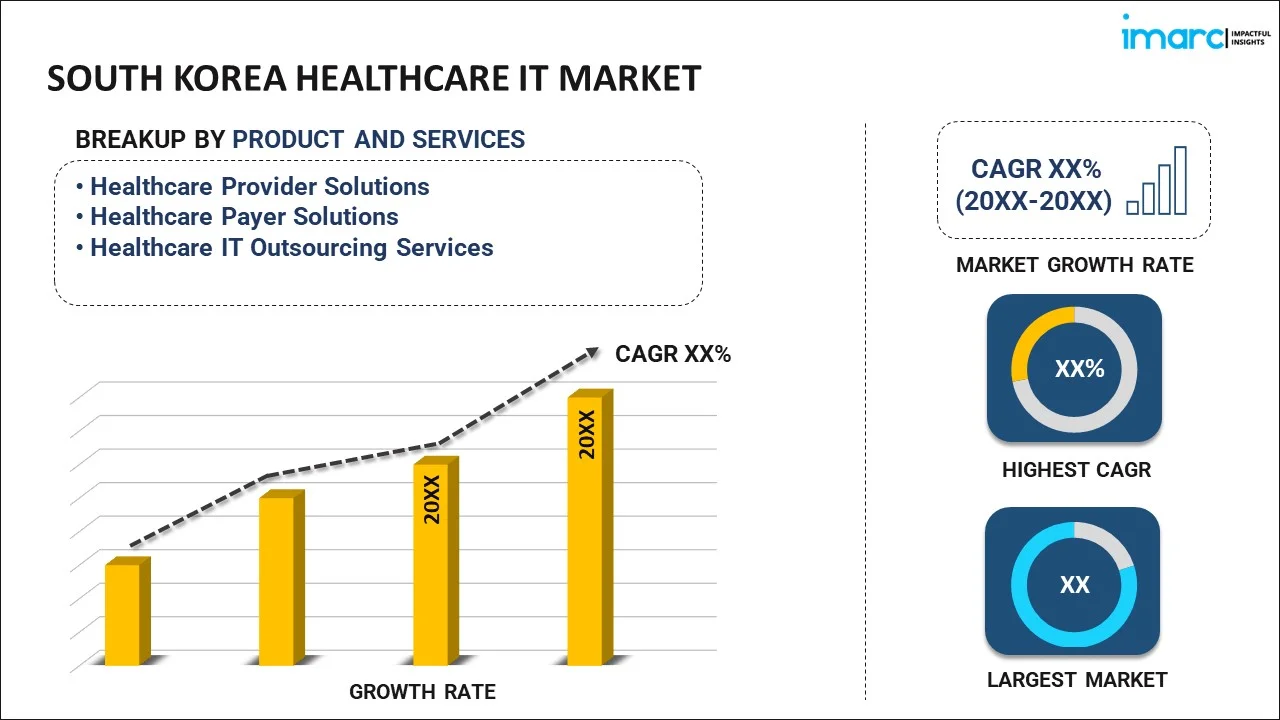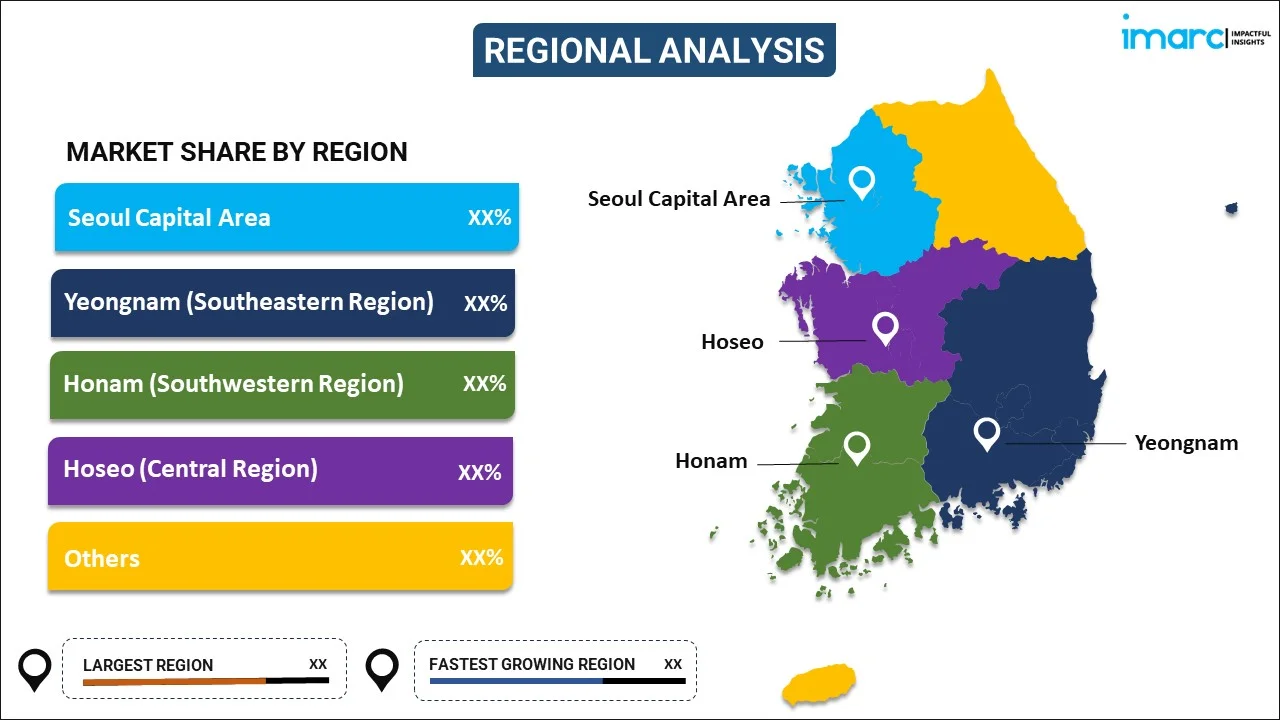
South Korea Healthcare IT Market Report by Product and Services (Healthcare Provider Solutions, Healthcare Payer Solutions, Healthcare IT Outsourcing Services), Component (Software, Hardware, Services), Delivery Mode (On-premises, Cloud-based), End User (Healthcare Providers, Healthcare Payers, and Others), and Region 2024-2032
Market Overview:
South Korea healthcare IT market size is projected to exhibit a growth rate (CAGR) of 8.70% during 2024-2032. The launch of healthcare quality improvement initiatives by government bodies, along with the inflating need for electronic health records (EHR), is primarily driving the market growth across the country.
|
Report Attribute
|
Key Statistics
|
|---|---|
|
Base Year
|
2023 |
|
Forecast Years
|
2024-2032
|
|
Historical Years
|
2018-2023
|
| Market Growth Rate (2024-2032) | 8.70% |
Healthcare information technology (IT) involves the utilization of information and communication technologies within the healthcare sector to oversee, store, and exchange patient information. This broad field encompasses various digital tools and systems aimed at enhancing the quality, efficiency, and safety of healthcare delivery. Components include electronic health records (EHRs), telemedicine platforms, health monitoring devices, medical billing and coding software, and data analytics applications. Healthcare IT allows instant access to patient data, streamlines administrative processes, and supports more informed decision-making. Patients experience improved access to medical services, reduced instances of medical errors, and enhanced healthcare outcomes. Moreover, Healthcare IT plays a crucial role in medical research and population health management by facilitating the sharing and analysis of data.
South Korea Healthcare IT Market Trends:
South Korea's healthcare IT market is driven by a confluence of technological innovation, a robust healthcare infrastructure, and a commitment to advancing patient care. Additionally, the integration of electronic health records (EHRs), telemedicine platforms, and health monitoring devices showcases the country's dedication to enhancing healthcare accessibility and efficiency. Besides this, the demand for digital tools that streamline administrative processes and facilitate data analytics is on the rise, contributing to improved decision-making in healthcare delivery. Moreover, government initiatives supporting the adoption of healthcare IT play a pivotal role, ensuring a cohesive and interconnected healthcare ecosystem. Apart from this, South Korea's tech-savvy population contributes to the successful implementation of telemedicine and patient-centric digital solutions, which is positively influencing the regional market. Furthermore, as the nation embraces the era of smart healthcare, healthcare IT trends in South Korea reflect a dynamic landscape, emphasizing patient outcomes, data-driven insights, and the seamless integration of technology into the healthcare experience. In line with this, these technologies provide valuable insights to support clinical decision-making, which is expected to fuel the regional market over the forecasted period.
South Korea Healthcare IT Market Segmentation:
IMARC Group provides an analysis of the key trends in each segment of the market, along with forecasts at the country level for 2024-2032. Our report has categorized the market based on product and services, component, delivery mode, and end user.
Product and Services Insights:

- Healthcare Provider Solutions
- Clinical Solutions
- Nonclinical Healthcare IT Solutions
- Healthcare Payer Solutions
- Pharmacy Audit and Analysis Systems
- Claims Management Solutions
- Analytics and Fraud Management Solutions
- Member Eligibility Management Solutions
- Provider Network Management Solutions
- Billing and Accounts (Payment) Management Solutions
- Customer Relationship Management Solutions
- Population Health Management Solutions
- Others
- Healthcare IT Outsourcing Services
- Provider HCIT Outsourcing Services Market
- Payer IT Outsourcing Services
- Operational IT Outsourcing Services
The report has provided a detailed breakup and analysis of the market based on the product and services. This includes healthcare provider solutions (clinical solutions and nonclinical healthcare IT solutions), healthcare payer solutions (pharmacy audit and analysis systems, claims management solutions, analytics and fraud management solutions, member eligibility management solutions, provider network management solutions, billing and accounts (payment) management solutions, customer relationship management solutions, population health management solutions, and others), and healthcare IT outsourcing services (provider HCIT outsourcing services market, payer IT outsourcing services, and operational IT outsourcing services).
Component Insights:
- Software
- Hardware
- Services
A detailed breakup and analysis of the market based on the component have also been provided in the report. This includes software, hardware, and services.
Delivery Mode Insights:
- On-premises
- Cloud-based
The report has provided a detailed breakup and analysis of the market based on the delivery mode. This includes on-premises and cloud-based.
End User Insights:
- Healthcare Providers
- Hospitals
- Ambulatory Care Centers
- Home Healthcare Agencies, Nursing Homes, and Assisted Living Facilities
- Diagnostic and Imaging Centers
- Pharmacies
- Healthcare Payers
- Private Payers
- Public Payers
- Others
A detailed breakup and analysis of the market based on the end user have also been provided in the report. This includes healthcare providers (hospitals, ambulatory care centers, home healthcare agencies, nursing homes, assisted living facilities, diagnostic and imaging centers, and pharmacies), healthcare payers (private payers and public payers), and others.
Regional Insights:

- Seoul Capital Area
- Yeongnam (Southeastern Region)
- Honam (Southwestern Region)
- Hoseo (Central Region)
- Others
The report has also provided a comprehensive analysis of all the major regional markets, which include Seoul Capital Area, Yeongnam (Southeastern Region), Honam (Southwestern Region), Hoseo (Central Region), and Others.
Competitive Landscape:
The market research report has also provided a comprehensive analysis of the competitive landscape in the market. Competitive analysis such as market structure, key player positioning, top winning strategies, competitive dashboard, and company evaluation quadrant has been covered in the report. Also, detailed profiles of all major companies have been provided.
South Korea Healthcare IT Market Report Coverage:
| Report Features | Details |
|---|---|
| Base Year of the Analysis | 2023 |
| Historical Period | 2018-2023 |
| Forecast Period | 2024-2032 |
| Units | US$ Million |
| Scope of the Report | Exploration of Historical and Forecast Trends, Industry Catalysts and Challenges, Segment-Wise Historical and Predictive Market Assessment:
|
| Product and Services Covered |
|
| Components Covered | Software, Hardware, Services |
| Deployment Modes Covered | On-premises, Cloud-based |
| End Users Covered |
|
| Regions Covered | Seoul Capital Area, Yeongnam (Southeastern Region), Honam (Southwestern Region), Hoseo (Central Region), Others |
| Customization Scope | 10% Free Customization |
| Report Price and Purchase Option | Single User License: US$ 3699 Five User License: US$ 4699 Corporate License: US$ 5699 |
| Post-Sale Analyst Support | 10-12 Weeks |
| Delivery Format | PDF and Excel through Email (We can also provide the editable version of the report in PPT/Word format on special request) |
Key Questions Answered in This Report:
- How has the South Korea healthcare IT market performed so far and how will it perform in the coming years?
- What has been the impact of COVID-19 on the South Korea healthcare IT market?
- What is the breakup of the South Korea healthcare IT market on the basis of product and services?
- What is the breakup of the South Korea healthcare IT market on the basis of component?
- What is the breakup of the South Korea healthcare IT market on the basis of delivery mode?
- What is the breakup of the South Korea healthcare IT market on the basis of end user?
- What are the various stages in the value chain of the South Korea healthcare IT market?
- What are the key driving factors and challenges in the South Korea healthcare IT?
- What is the structure of the South Korea healthcare IT market and who are the key players?
- What is the degree of competition in the South Korea healthcare IT market?
Key Benefits for Stakeholders:
- IMARC’s industry report offers a comprehensive quantitative analysis of various market segments, historical and current market trends, market forecasts, and dynamics of the South Korea healthcare IT market from 2018-2032.
- The research report provides the latest information on the market drivers, challenges, and opportunities in the South Korea healthcare IT market.
- Porter's five forces analysis assist stakeholders in assessing the impact of new entrants, competitive rivalry, supplier power, buyer power, and the threat of substitution. It helps stakeholders to analyze the level of competition within the South Korea healthcare IT industry and its attractiveness.
- Competitive landscape allows stakeholders to understand their competitive environment and provides an insight into the current positions of key players in the market.
Need more help?
- Speak to our experienced analysts for insights on the current market scenarios.
- Include additional segments and countries to customize the report as per your requirement.
- Gain an unparalleled competitive advantage in your domain by understanding how to utilize the report and positively impacting your operations and revenue.
- For further assistance, please connect with our analysts.
 Inquire Before Buying
Inquire Before Buying
 Speak to an Analyst
Speak to an Analyst
 Request Brochure
Request Brochure
 Request Customization
Request Customization




.webp)




.webp)












